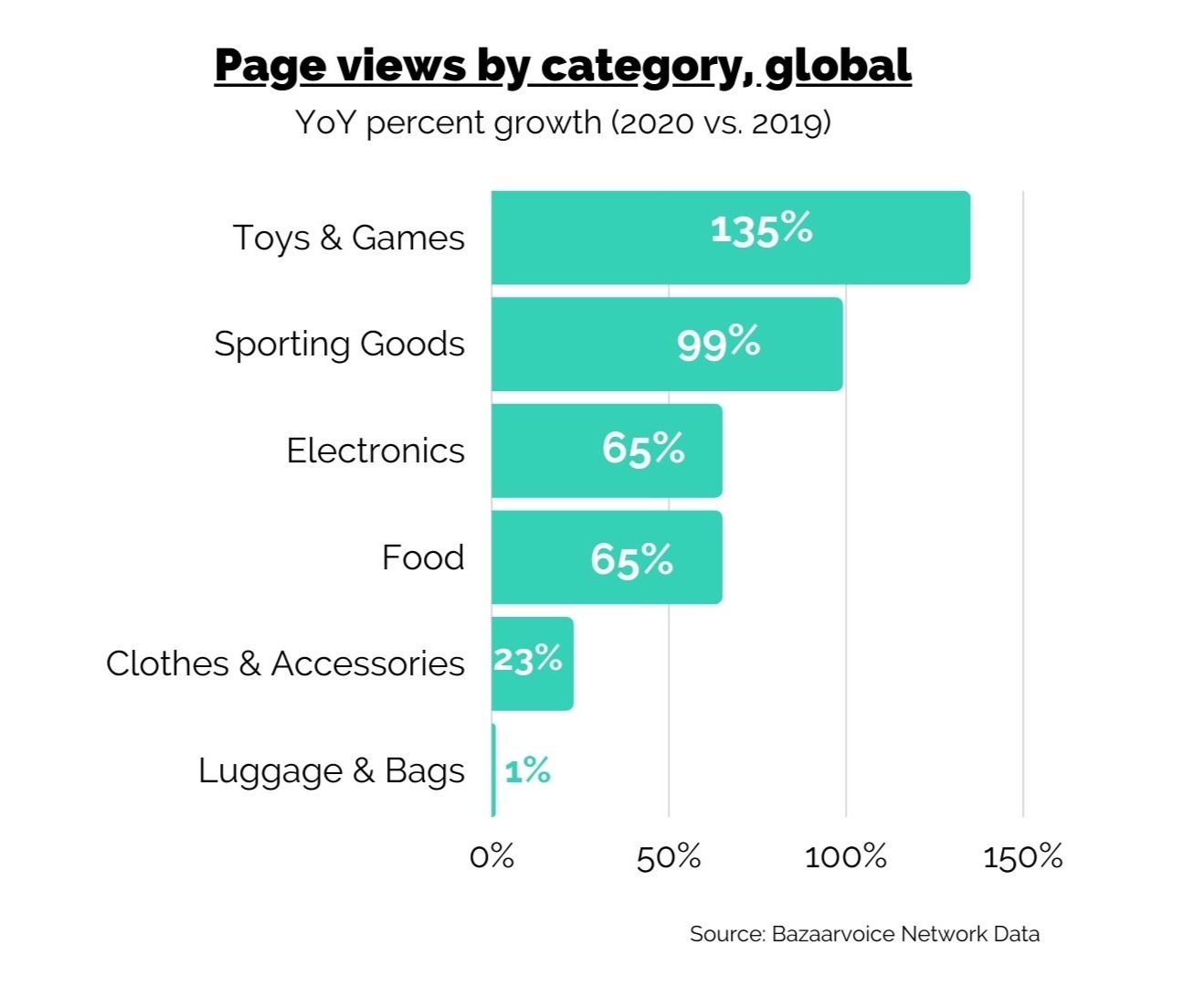
With the Covid-19 scaring away all possible human interaction opportunities, customers are quickly moving towards e-commerce channels for all their shopping needs. From clothing and furniture to groceries and electronics– everything is being put on the dot com, and almost all categories have seen a strong YoY growth owing to the pandemic.

The following chart illustrates the global growth of page views by category from 2019 to 2020. We can see a clear growth in toys and games (135%) and sporting goods (99%) which is clearly related to the lockdown that took place in most countries through the first half of 2020. The lockdown forced people to stay at home and find ways to do to stay entertained through games and sport exercises fit for the indoors.
We can also see a growth in electronics and food (65% both), caused for the same reason. With the need to stay indoors as much as possible, some people jumped to the dotcom to do their grocery shopping and electronics became even a more important part of our lives as we found ways to keep entertained during the long hours inside.
Clothes and accessories saw a small but meaningful growth (23%) as well. During the global lockdown, many apparel stores worldwide had to close down their stores and jump into the e-commerce scene to keep their activity alive. This growth is expected to continue increasing as customers discover the perks of shopping online. The Covid-19 outbreak has in fact accelerated e-commerce growth by 4-6 years, and this volume is likely to surge further, as the fear of consecutive pandemic waves implies that people will continue to socially distance themselves from traditional shopping.
Interestingly enough, even as the lockdown has started easing out in some countries, new shopping habits are likely to stick around.
1. Increased convenience
As customers have grown used to the convenience of online shopping, these new habits are quickly becoming the new normal. Easy check-out, buy-now-pay-later, same-day delivery and free returns are some of the perks of online shopping.
2. Try-before-you-buy
Customers are getting used to ordering more than one product size or style and using their bedroom as the fitting room. The "buy" decision does not happen when checking-out anymore, but at home when unpacking the product.
3. Rise of omnichannel shopping
Even as lockdown loosens, people are sceptical to shop outside. However, customers are growing used to the flexibility of seamlessly shifting between online and offline channels as BOPIS (Buy-Online-Pickup-In-Stores) and BORIS (Buy-Online-Return-In-Stores) sees increased demand.
How has this affected the industry?
Retailers have been proactive in taking steps to adapt their businesses to these changing habits, especially as platforms like Shopify or Facebook Shop have made it easy for millions of businesses to go online quickly and conveniently. Moreover, the growing e-commerce market has bought in several tools and technologies that allow retailers to accompany their customers from search to checkout and smoothen their shopping experience.
However, when focusing on increasing acquisition, retailers often forget that the customer journey doesn't end at the checkout. It's equally, if not more crucial, that retailers take care of their customers post-purchase because any small slip-up would be enough to increase churn.
The Covid-19 pandemic has raised several new roadblocks that affect the overall post-purchase experience for customers. The two major roadblocks are supply chain complexities and lagging customer service.
It's equally, if not more crucial, that retailers take care of their customers post-purchase because any small slip-up would be enough to increase churn.
Supply chain complexities
The sudden boom in e-commerce has thrown a complex curve-ball at retailers when it comes to handling their orders. Their inability to predict demand coupled with limited available labour, as resulted in frequent stock-outs, and consequently, several delayed or cancelled deliveries. This can severely impact the customer's experience with the brand. Moreover, as the manually shipped returns surge, it has become increasingly difficult to track and sort them properly, thus resulting in mix-ups, unnecessary losses and frequent refund delays.
Lagging Customer Service
Thanks to the above post-purchase complexities, customer service teams are getting swamped with calls and are struggling to satisfy their customers’ grievances adequately and in time. The fact that most of the team is working from home also makes it difficult for them to communicate in a coordinated manner, thus, making the process even slower and frustrating for their customers.
This can inadvertently result in high customer dissatisfaction and correspondingly churn.
But, what if we told you that the post-purchase experience could actually become a moment where brands could excel in their customer experience offering, connect and engage with their customers to ensure long term loyalty.
The customer experience has changed and retailers have to find ways to adapt fast to stay alive in the competitive sector. With online shopping taking off at speed of lightning, it’s important to not only digitalise your store but also your return process. Because believe us, there’re going to be returns and you want to be ready for them.
yayloh is a post-purchase and returns management platform that will help you deliver the best customer experience, reduce returns, time and costs and win customers for life.





.png)

.png)

